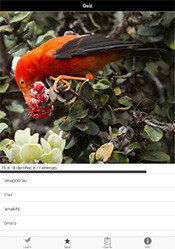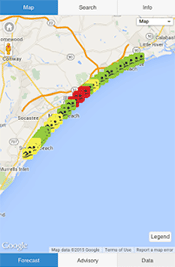Your input helps the Bay
In partnership with The Chesapeake Bay Trust, and OpinionWorks, the University of Maryland has launched The Bay Survey. This survey helps us understand how residents throughout the Chesapeake Bay area, Western Maryland, and the Atlantic Coastal Bays handle rainwater, vegetation, and other issues on their properties. Help out IAN by filling out the survey online at www.baysurvey.org.Video & Blog Highlights
Video
- Peter Claggett presented the latest Science for Citizens seminar titled "Land Change Forecasts and Vulnerability Assessments" which is now posted to IAN's website and YouTube.
Blog
- Fifteen students, ten minutes: One humbling education
- The future of managing fisheries: what can we expect?
- Hire me, I'm a Scientist! Career challenges for students
Our Path Forward: The Comprehensive Conservation & Management Plan for Maryland Coastal Bays (2015-2025)
 Our Path Forward represents a revision to the 1999 Comprehensive Conservation & Management Plan for the Coastal Bays of Maryland. The work is the culmination of three years (2012-2014) of technical investigation and community involvement to protect the future of the Coastal Bays.
Our Path Forward represents a revision to the 1999 Comprehensive Conservation & Management Plan for the Coastal Bays of Maryland. The work is the culmination of three years (2012-2014) of technical investigation and community involvement to protect the future of the Coastal Bays.
Hawaii Forest Birds app released
 IAN has completed a bird identification and survey simulation app for the National Park Service Pacific Network. The app leads users on a tutorial for identification using photos, songs, and important anatomical features. It quizzes users on their knowledge, and tests skills using a bird identification game. The app is intended to simulate a bird survey in areas of the Haleakalā and Hawaiʻi Volcanoes National Parks which most of the public will likely never visit. The app is available for free on iTunes and the Google Play Store.
IAN has completed a bird identification and survey simulation app for the National Park Service Pacific Network. The app leads users on a tutorial for identification using photos, songs, and important anatomical features. It quizzes users on their knowledge, and tests skills using a bird identification game. The app is intended to simulate a bird survey in areas of the Haleakalā and Hawaiʻi Volcanoes National Parks which most of the public will likely never visit. The app is available for free on iTunes and the Google Play Store.
Floodplain connections in Kakadu National Park
 The multi-year research studies on the floodplain ecosystems and their resources of Kakadu National Park in the Northern Territory of Australia are wrapping up. IAN has been working with the National Environmental Research Program Northern Hub at Charles Darwin University to help synthesize the results of this research. The goal of the project is to communicate the key findings of research on Kakadu floodplains, and recommendations for managing threats to those resources from invasive species, climate change, and saltwater intrusion. To that end, a series of workshops have been conducted, with the most recent one being May 18-19 in Brisbane, where Dr. Heath Kelsey and Jane Hawkey met with a team of the research scientists.
The multi-year research studies on the floodplain ecosystems and their resources of Kakadu National Park in the Northern Territory of Australia are wrapping up. IAN has been working with the National Environmental Research Program Northern Hub at Charles Darwin University to help synthesize the results of this research. The goal of the project is to communicate the key findings of research on Kakadu floodplains, and recommendations for managing threats to those resources from invasive species, climate change, and saltwater intrusion. To that end, a series of workshops have been conducted, with the most recent one being May 18-19 in Brisbane, where Dr. Heath Kelsey and Jane Hawkey met with a team of the research scientists.
How's the Beach? water quality app released
 IAN and the University of South Carolina unveiled the "How's the beach?" water quality prediction app last month. Using data provided by the NOAA National Weather Service, the app provides daily forecasts of beach bacteria concentration at 31 locations along the Myrtle Beach, South Carolina "Grand Strand". The app also provides the latest available bacteria monitoring data, and the current advisory status as issued by the South Carolina department of Health and Environmental Control. We are currently working to expand the app to a new area near St. Petersburg, Florida. The app is available for free on iTunes and the Google Play Store.
IAN and the University of South Carolina unveiled the "How's the beach?" water quality prediction app last month. Using data provided by the NOAA National Weather Service, the app provides daily forecasts of beach bacteria concentration at 31 locations along the Myrtle Beach, South Carolina "Grand Strand". The app also provides the latest available bacteria monitoring data, and the current advisory status as issued by the South Carolina department of Health and Environmental Control. We are currently working to expand the app to a new area near St. Petersburg, Florida. The app is available for free on iTunes and the Google Play Store.
On the Horizon...
- A new course, Communicating Science Effectively, will be offered by the Integration and Application Network during the fall semester 2015. This course will focus on developing effective strategies for communicating scientific findings using a variety of data visualization tools, including conceptual diagrams, informative maps, photographs, and video clips. This 3-credit course will be offered through the University of Maryland Marine, Estuarine, Environmental Sciences graduate program. Please stay tuned for registration information!
- IAN is a partner in a multi-year EPA-funded grant to integrate citizen science and nontraditional monitoring data into the Chesapeake Bay Program's monitoring framework. The Alliance for the Chesapeake Bay and the Izaak Walton League are leading this new partnership, which also includes Alliance for Aquatic Resource Monitoring (ALLARM). Come to the Mid-Atlantic Volunteer Monitoring Conference in August to find out more about this project!

